Wikipedia:Picture of the day/December 2013
|
Featured picture tools: |
These featured pictures, as scheduled below, appeared as the picture of the day (POTD) on the English Wikipedia's Main Page in December 2013. Individual sections for each day on this page can be linked to with the day number as the anchor name (e.g. [[Wikipedia:Picture of the day/December 2013#1]] for December 1).
You can add an automatically updating POTD template to your user page using {{Pic of the day}} (version with blurb) or {{POTD}} (version without blurb). For instructions on how to make custom POTD layouts, see Wikipedia:Picture of the day.Purge server cache
December 1

|
|
Space Shuttle Atlantis (foreground) sits on Launch Pad A and Endeavour on Launch Pad B at NASA's Kennedy Space Center in Florida in 2008. Endeavour stood by at pad B in case a rescue mission was necessary during Atlantis' mission to repair NASA's Hubble Space Telescope. At the left of each shuttle are the open rotating service structures, with the payload changeout rooms visible. These structures provided weather protection and access to the shuttle. Photo: NASA/Troy Cryder
Recently featured:
|
December 2

|
The European wildcat (Felis silvestris silvestris) is a subspecies of wildcat that inhabits the forests and grasslands of Europe, as well as Turkey and the Caucasus Mountains; it can be distinguished from the domestic cat by its bulkier body, thick fur, and non-tapered tail. This cat was photographed in Wisentgehege Springe game park, near Springe, Hanover, Germany. Photo: Michael Gäbler |
December 3

|
Tachina praeceps, one of more than 600 species in the fly genus Tachina, part of the suborder Brachycera. The suborder is best differentiated from other fly suborders by the reduced antenna segmentation. Photo: Alvesgaspar |
December 4
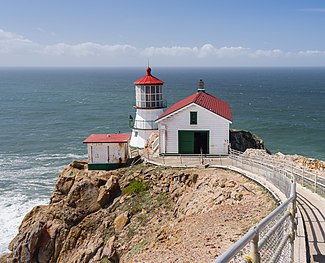
|
The Point Reyes Lighthouse is a lighthouse in the Gulf of the Farallones on Point Reyes in Marin County, California. Built in 1870 as a twin of the Cape Mendocino Light, the Point Reyes Lighthouse was automated in 1975 and listed on the National Register of Historic Places in 1991. Photo: Frank Schulenburg
Recently featured:
|
December 5

|
Martin Van Buren (1782–1862) was the eighth president of the United States, serving from 1837 to 1841. Earlier, he was the eighth vice president (1833–1837), and before that, the tenth secretary of state (1829–1831), both under Andrew Jackson. Photo: Mathew Brady
Recently featured:
|
December 6

|
Wulfenite is a lead molybdate mineral with the formula PbMoO4. It can be most often found as thin tabular crystals with a bright orange-red to yellow-orange color, sometimes brown, although the color can be highly variable. This specimen was collected in Mexico. Photo: Didier Descouens
Recently featured:
|
December 7

|
The sinking USS Arizona, photographed shortly after the attack on Pearl Harbor, Hawaii. On 7 December 1941, Japanese aircraft struck the US' Pacific Fleet while in port. Arizona was struck several times before a bomb blew up the forward ammunition magazines, causing a cataclysmic explosion. The ship's destruction killed 1,177 of the 1,512 crewmen on board at the time, representing almost half of the American fatalities in the attack. Photo: Unknown; Restoration: Mmxx
Recently featured:
|
December 8

|
Mating Ulysses butterflies (Papilio ulysses), photographed in Vienna, Austria. Females, such as the top specimen here, can be distinguished from males by crescents of blue in the back, upside sections of their hind wings. Photo: Michael Gäbler
Recently featured:
|
December 9
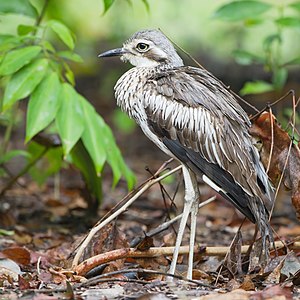
|
The Bush Stone-curlew (Burhinus grallarius) is a large bird endemic to Australia. This nocturnal bird is a terrestrial predator which specialises in hunting small grassland animals. Though it lives mostly on the ground, it is also capable of flight. Photo: JJ Harrison
Recently featured:
|
December 10
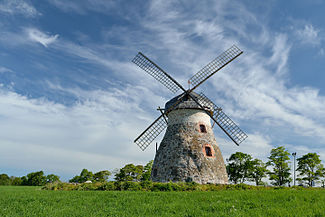
|
Windmills are machines which convert the energy of wind into rotational energy by means of vanes called sails or blades. Originally used for milling grain, they have been adapted to many other uses. This windmill was photographed in Kuremaa, Estonia. Photo: Ivar Leidus
Recently featured:
|
December 11

|
A section of the Israel–Egypt barrier, north of Eilat. Initially built by the Israeli government to keep out illegal immigrants and smugglers, the fence has been upgraded and expanded in order to prevent penetration by terrorists. Photo: Idobi1
Recently featured:
|
December 12

|
An accordion player in a street in the historic centre of Quito, Ecuador. The instrument is played by compressing or expanding the bellows to generate a flow of air, while pressing buttons or keys to open valves (called pallets). This directs the air across strips of brass or steel (called reeds) that vibrate to produce sound inside the body. The performer normally plays the melody on the right-hand keyboard, and the accompaniment, consisting of bass and pre-set chord buttons, on the left-hand one. Photo: Claude Meisch
Recently featured:
|
December 13
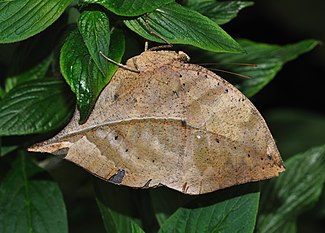
|
Kallima inachus, also known as the Dead Leaf or Orange Oakleaf, is a nymphalid butterfly found in tropical Asia. The species uses mimicry, resembling a dead leaf when it closes its wings, in order to avoid predators. Photo: Quartl
Recently featured:
|
December 14

|
The Olive Whistler (Pachycephala olivacea) is a species of bird of the whistler family Pachycephalidae that is native to southeastern Australia. Adults measure around 18–20 cm (7–8 in) long. The species' call has been likened to "I'll wet you" or "You're cranky". Photo: JJ Harrison
Recently featured:
|
December 15

|
A diagram showing an aboral view of a partially dissected starfish
Diagram: Hans Hillewaert
Recently featured:
|
December 16
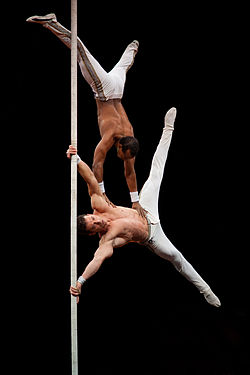
|
Two Cuban acrobats on the Chinese pole, performing at Grenoble. Chinese poles are vertical poles on which circus performers climb, slide down and hold poses. The poles are generally between 3 and 9 metres (10 and 30 ft) in height and approximately 5 to 8 cm (2 to 3 inches) in diameter. Photo: Ludovic Péron
Recently featured:
|
December 17
|
Eureka Tower is a 297.3-metre (975 ft) skyscraper located in Melbourne, Victoria, Australia. Construction began in August 2002 and the building was officially opened on 11 October 2006. The project was designed by Melbourne architectural firm Fender Katsalidis Architects and was built by Grocon. As of May 2013 it is the 12th tallest residential building in the world. Photo: David Iliff
Recently featured:
|
December 18
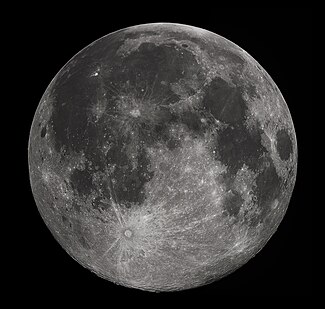
|
The Moon is the only natural satellite of Earth and the fifth largest moon in the Solar System. Owing to its synchronous rotation around Earth, the Moon always shows the same face: its near side, which is marked by dark volcanic maria as well as the bright ancient crustal highlands and the prominent impact craters. Here, the Moon was near its greatest northern ecliptic latitude, so the southern craters are especially prominent. Photo: Gregory H. Revera
Recently featured:
|
December 19

|
Dendrobates azureus, commonly known as the blue poison dart frog or okopipi, is a poison dart frog found in the forests surrounded by the Sipaliwini Savanna in southern Suriname. Authorities have recently treated it as a variant of Dendrobates tinctorius rather than a distinct species as before. Photo: Quartl
Recently featured:
|
December 20

|
Taagepera Castle is a mansion in Taagepera village, Helme Parish, Valga County, Estonia. It currently serves as a hotel. Photo: Ivar Leidus
Recently featured:
|
December 21
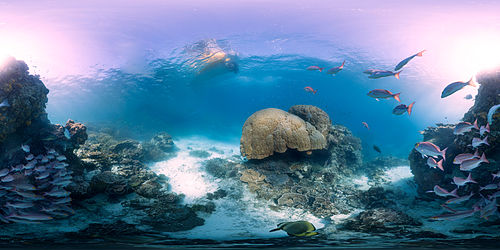
|
|
A 360° panorama of the coral reef near Heron Island, Queensland, Australia, along the Great Barrier Reef. The image was taken with the Seaview SVII underwater survey camera, which is being used by the Catlin Seaview Survey to create visual records of the health of coral reefs and to raise public awareness of threats to coral reefs. The distortion evident near the top and bottom of the image is the result of rendering this image in a rectangular form rather than a 3D model. (View as a 360° panorama on the Toolserver) Photo: Underwater Earth/Catlin Seaview Survey
Recently featured:
|
December 22

|
A potter at work in Jaura, Madhya Pradesh, India. Pottery, defined by ASTM International as "all fired ceramic wares that contain clay when formed, except technical, structural, and refractory products", originated during the Neolithic period. Photo: Yann
Recently featured:
|
December 23
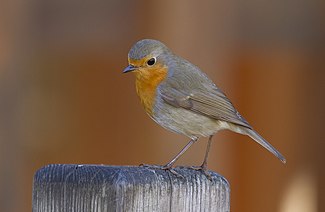
|
The European Robin (Erithacus rubecula) is a small insectivorous passerine bird that was formerly classed as a member of the thrush family (Turdidae), but is now considered to be a chat. Around 12.5–14.0 cm (5.0–5.5 in) in length, the male and female are similar in colouration, with an orange breast and face lined with grey, brown upperparts and a whitish belly. Photo: Pierre-Selim
Recently featured:
|
December 24

|
Galina Vishnevskaya (1926–2012) was a Russian soprano opera singer and recitalist who was named a People's Artist of the USSR in 1966. During her nearly six-decade career she toured much of Europe and the United States. She also acted in a film, Alexander Sokurov's Alexandra (2007). Photo: Alexey Yushenkov; edit: David Iliff
Recently featured:
|
December 25

|
"The Lamb" is a poem by William Blake, published in Songs of Innocence and of Experience in 1789. In the first stanza, the speaker asks the lamb – considered a pure and gentle creature – who his creator is. In the second stanza, comparisons are made between the lamb and the infant Jesus, as well as between the lamb and the speaker's soul. In the last two lines the speaker identifies the lamb's creator as God. Illustration: William Blake; restoration: Adam Cuerden
Recently featured:
|
December 26

|
Space Shuttle Endeavour in a photograph taken from the International Space Station, in which the shuttle appears to straddle the stratosphere and mesosphere. During this mission, STS-130, the shuttle's primary payloads were the Tranquility module and the Cupola, a robotic control station which provides a 360-degree view around the station. Photo: NASA/Crew of Expedition 22
Recently featured:
|
December 27

|
Morpho peleides, also known as the Peleides Blue Morpho, Common Morpho, or The Emperor, is an iridescent tropical butterfly found in the Western Hemisphere. The brilliant blue color in the butterfly's wings is caused by the diffraction of the light from millions of tiny scales on its wings. Photo: Thomas Bresson
Recently featured:
|
December 28

|
The Bar-backed Partridge (Arborophila brunneopectus; top: male, bottom: female) is a species of partridge in the family Phasianidae, found in Southeast Asia and China. It is typically 28 centimetres (11 in) long and mostly buff in color. It feeds on seeds and small insects on the forest floor. Photo: JJ Harrison
Recently featured:
|
December 29

|
Sign painting is the art of painting announcements or advertisements on buildings, billboards or signboards. The occupation has become less common with the advent of computer printing. Here two painters are creating a new sign on a wall of the Figueroa Hotel in Los Angeles, California. Photo: John O'Neill
Recently featured:
|
December 30
Subpage 1

|
The frontispiece to the first printing of Rudyard Kipling's 1906 fantasy book Puck of Pook's Hill, featuring the legend "They saw a small, brown ... pointy-eared person ... step quietly into the Ring". The book consists of a number of stories, all narrated to two children living near Burwash, in the area of Kipling's own house Bateman's, by people magically plucked out of history by the elf Puck, or told by Puck himself.
Illustrator: Harold Robert Millar; restoration: Adam Cuerden
Recently featured:
|
Subpage 2

|
An illustration from the story "Weyland's Sword" from the first printing of Rudyard Kipling's 1906 fantasy book Puck of Pook's Hill, featuring the legend "Then he made a sword". The book consists of a number of stories, all narrated to two children living near Burwash, in the area of Kipling's own house Bateman's, by people magically plucked out of history by the elf Puck, or told by Puck himself.
Illustrator: Harold Robert Millar; restoration: Adam Cuerden
Recently featured:
|
Subpage 3

|
An illustration from the story "Young Men at the Manor" from the first printing of Rudyard Kipling's 1906 fantasy book Puck of Pook's Hill, featuring the legend "At this she cried that I was a Norman thief". The book consists of a number of stories, all narrated to two children living near Burwash, in the area of Kipling's own house Bateman's, by people magically plucked out of history by the elf Puck, or told by Puck himself.
Illustrator: Harold Robert Millar; restoration: Adam Cuerden
Recently featured:
|
Subpage 4

|
An illustration from the story "Young Men at the Manor" from the first printing of Rudyard Kipling's 1906 fantasy book Puck of Pook's Hill, featuring the legend "Said he, 'I have it all from the child here'". The book consists of a number of stories, all narrated to two children living near Burwash, in the area of Kipling's own house Bateman's, by people magically plucked out of history by the elf Puck, or told by Puck himself.
Illustrator: Harold Robert Millar; restoration: Adam Cuerden
Recently featured:
|
Subpage 5

|
An illustration from the story "Young Men at the Manor" from the first printing of Rudyard Kipling's 1906 fantasy book Puck of Pook's Hill, featuring the legend "'Sir Richard, will it please you enter your Great Hall?'". The book consists of a number of stories, all narrated to two children living near Burwash, in the area of Kipling's own house Bateman's, by people magically plucked out of history by the elf Puck, or told by Puck himself.
Illustrator: Harold Robert Millar; restoration: Adam Cuerden
Recently featured:
|
Subpage 6
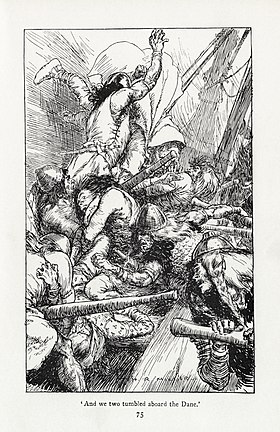
|
An illustration from the story "The Knights of the Joyous Venture" from the first printing of Rudyard Kipling's 1906 fantasy book Puck of Pook's Hill, featuring the legend "'And we two tumbled aboard the Dane'". The book consists of a number of stories, all narrated to two children living near Burwash, in the area of Kipling's own house Bateman's, by people magically plucked out of history by the elf Puck, or told by Puck himself.
Illustrator: Harold Robert Millar; restoration: Adam Cuerden
Recently featured:
|
Subpage 7

|
An illustration from the story "The Knights of the Joyous Venture" from the first printing of Rudyard Kipling's 1906 fantasy book Puck of Pook's Hill, featuring the legend "Thorkild had given back before his Devil, till the bowmen on the ship could shoot it all full of arrows". The book consists of a number of stories, all narrated to two children living near Burwash, in the area of Kipling's own house Bateman's, by people magically plucked out of history by the elf Puck, or told by Puck himself.
Illustrator: Harold Robert Millar; restoration: Adam Cuerden
Recently featured:
|
Subpage 8

|
An illustration from the story "The Knights of the Joyous Venture" from the first printing of Rudyard Kipling's 1906 fantasy book Puck of Pook's Hill, featuring the legend "'So we called no more'". The book consists of a number of stories, all narrated to two children living near Burwash, in the area of Kipling's own house Bateman's, by people magically plucked out of history by the elf Puck, or told by Puck himself.
Illustrator: Harold Robert Millar; restoration: Adam Cuerden
Recently featured:
|
Subpage 9

|
An illustration from the story "Old Men at Pevensey" from the first printing of Rudyard Kipling's 1906 fantasy book Puck of Pook's Hill, featuring the legend "'A' God's Name write her free, before she deafens me!'". The book consists of a number of stories, all narrated to two children living near Burwash, in the area of Kipling's own house Bateman's, by people magically plucked out of history by the elf Puck, or told by Puck himself.
Illustrator: Harold Robert Millar; restoration: Adam Cuerden
Recently featured:
|
Subpage 10

|
An illustration from the story "Old Men at Pevensey" from the first printing of Rudyard Kipling's 1906 fantasy book Puck of Pook's Hill, featuring the legend "He drew his dagger on Jehan, who threw him down the stairway". The book consists of a number of stories, all narrated to two children living near Burwash, in the area of Kipling's own house Bateman's, by people magically plucked out of history by the elf Puck, or told by Puck himself.
Illustrator: Harold Robert Millar; restoration: Adam Cuerden
Recently featured:
|
Subpage 11

|
An illustration from the story "A Centurion of the Thirtieth" from the first printing of Rudyard Kipling's 1906 fantasy book Puck of Pook's Hill, featuring the legend "'You put the bullet into that loop'". The book consists of a number of stories, all narrated to two children living near Burwash, in the area of Kipling's own house Bateman's, by people magically plucked out of history by the elf Puck, or told by Puck himself.
Illustrator: Harold Robert Millar; restoration: Adam Cuerden
Recently featured:
|
Subpage 12

|
An illustration from the story "On the Great Wall" from the first printing of Rudyard Kipling's 1906 fantasy book Puck of Pook's Hill, featuring the legend "'And that is the Wall!'". The book consists of a number of stories, all narrated to two children living near Burwash, in the area of Kipling's own house Bateman's, by people magically plucked out of history by the elf Puck, or told by Puck himself.
Illustrator: Harold Robert Millar; restoration: Adam Cuerden
Recently featured:
|
Subpage 13

|
An illustration from the story "The Winged Hats" from the first printing of Rudyard Kipling's 1906 fantasy book Puck of Pook's Hill, featuring the legend "'Hail, Caesar!'". The book consists of a number of stories, all narrated to two children living near Burwash, in the area of Kipling's own house Bateman's, by people magically plucked out of history by the elf Puck, or told by Puck himself.
Illustrator: Harold Robert Millar; restoration: Adam Cuerden
Recently featured:
|
Subpage 14
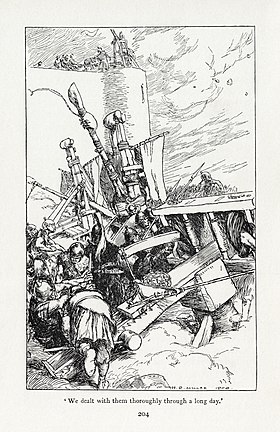
|
An illustration from the story "The Winged Hats" from the first printing of Rudyard Kipling's 1906 fantasy book Puck of Pook's Hill, featuring the legend "'We dealt with them thoroughly through a long day'". The book consists of a number of stories, all narrated to two children living near Burwash, in the area of Kipling's own house Bateman's, by people magically plucked out of history by the elf Puck, or told by Puck himself.
Illustrator: Harold Robert Millar; restoration: Adam Cuerden
Recently featured:
|
Subpage 15
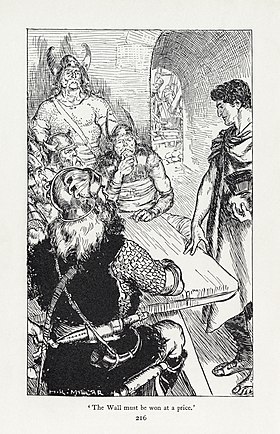
|
An illustration from the story "The Winged Hats" from the first printing of Rudyard Kipling's 1906 fantasy book Puck of Pook's Hill, featuring the legend "'The Wall must be won at a price'". The book consists of a number of stories, all narrated to two children living near Burwash, in the area of Kipling's own house Bateman's, by people magically plucked out of history by the elf Puck, or told by Puck himself.
Illustrator: Harold Robert Millar; restoration: Adam Cuerden
Recently featured:
|
Subpage 16
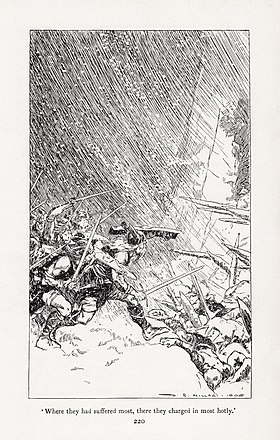
|
An illustration from the story "The Winged Hats" from the first printing of Rudyard Kipling's 1906 fantasy book Puck of Pook's Hill, featuring the legend "Where they had suffered most, there they charged in most hotly". The book consists of a number of stories, all narrated to two children living near Burwash, in the area of Kipling's own house Bateman's, by people magically plucked out of history by the elf Puck, or told by Puck himself.
Illustrator: Harold Robert Millar; restoration: Adam Cuerden
Recently featured:
|
Subpage 17
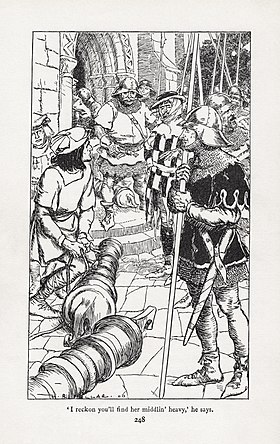
|
An illustration from the story "Hal o' the Draft" from the first printing of Rudyard Kipling's 1906 fantasy book Puck of Pook's Hill, featuring the legend "'I reckon you'll find her middlin' heavy,' he says". The book consists of a number of stories, all narrated to two children living near Burwash, in the area of Kipling's own house Bateman's, by people magically plucked out of history by the elf Puck, or told by Puck himself.
Illustrator: Harold Robert Millar; restoration: Adam Cuerden
Recently featured:
|
Subpage 18

|
An illustration from the story "Dymchurch Flit" from the first printing of Rudyard Kipling's 1906 fantasy book Puck of Pook's Hill, featuring the legend "'I know what sort o' man you be,' old Hobden grunted, groping for the potatoes". The book consists of a number of stories, all narrated to two children living near Burwash, in the area of Kipling's own house Bateman's, by people magically plucked out of history by the elf Puck, or told by Puck himself.
Illustrator: Harold Robert Millar; restoration: Adam Cuerden
Recently featured:
|
Subpage 19

|
An illustration from the story "The Treasure and the Law" from the first printing of Rudyard Kipling's 1906 fantasy book Puck of Pook's Hill, featuring the legend "Doors shut, candles lit". The book consists of a number of stories, all narrated to two children living near Burwash, in the area of Kipling's own house Bateman's, by people magically plucked out of history by the elf Puck, or told by Puck himself.
Illustrator: Harold Robert Millar; restoration: Adam Cuerden
Recently featured:
|
Subpage 20

|
An illustration from the story "The Treasure and the Law" from the first printing of Rudyard Kipling's 1906 fantasy book Puck of Pook's Hill, featuring the legend "'They drove me across the drawbridge'". The book consists of a number of stories, all narrated to two children living near Burwash, in the area of Kipling's own house Bateman's, by people magically plucked out of history by the elf Puck, or told by Puck himself.
Illustrator: Harold Robert Millar; restoration: Adam Cuerden
Recently featured:
|
December 31

|
Nocturne in Black and Gold – The Falling Rocket is a painting by James Abbott McNeill Whistler, completed circa 1875, that exemplified the art for art's sake movement. The painting, which shows a foggy fireworks display in the night sky and was inspired by the Cremorne Gardens in London, drew heated criticism from art critic John Ruskin, who accused Whistler of "flinging a pot of paint in the public's face". In the libel suit which followed, the court awarded a single farthing to Whistler, who was forced to share it with Ruskin; the artist declared bankruptcy soon afterwards, his paintings having quickly lost their popularity. Painting: James Abbott McNeill Whistler
Recently featured:
|
Picture of the day archives and future dates

